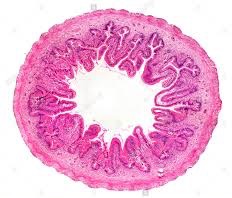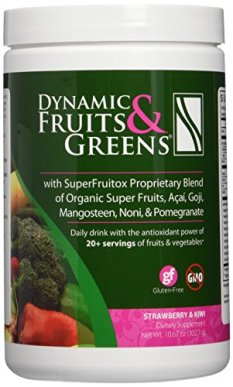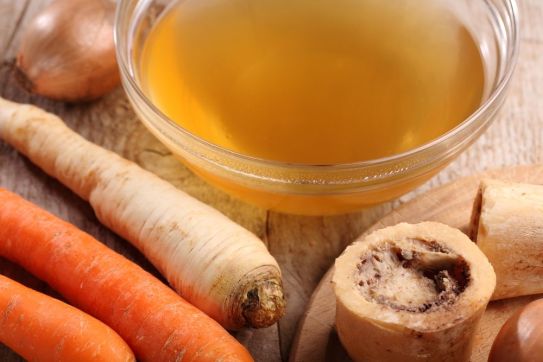We’re nearing the end of the series on digestion but we haven’t even gotten to the place where 90% of digestion actually happens! With only 10% happening in the mouth, stomach, and large intestine, all 22 feet of the small intestine is needed for the majority of the digestion and absorption of our food.
The first segment of the small intestine is called the duodenum. This is sort of a holding tank, in a way. This is where the hopefully super acidic glob of food comes after it’s released from the stomach. That acid, however, would burn itself right through the intestinal lining so a substance called bicarbonate is summoned from the pancreas. This bicarbonate raises the pH of the food blob closer to “neutral”. The pancreas also spills out a bunch of enzymes to come and keep breaking down the chemical content of the food. Lastly, our gallbladders secrete bile to break down fats. By the time the blob (it’s called chyme, by the way) is ready to travel into the next section of the small intestine, the carbohydrates have been broken into their smallest part, glucose molecules, the proteins have been broken into amino acids, and the fats fatty acids.
This breakdown of nutrients doesn’t mean anything if we can’t absorb them. That  happens in the next section, the jejunum. The jejunum is lined with millions of little finger-like protrusions called villi; each villus (I had to look that up…) lined with a ton o microvilli. These little guys grab onto the small molecules as they pass by. Eventually the nutrients pass through the membrane of the small intestine, into the bloodstream or lymphatic system, and to the liver for processing/storage or to certain cells for immediate use.
happens in the next section, the jejunum. The jejunum is lined with millions of little finger-like protrusions called villi; each villus (I had to look that up…) lined with a ton o microvilli. These little guys grab onto the small molecules as they pass by. Eventually the nutrients pass through the membrane of the small intestine, into the bloodstream or lymphatic system, and to the liver for processing/storage or to certain cells for immediate use.
Everything I just described only occurs in an ideal digestive situation: you relaxed and got your body ready for food, you chewed thoroughly, and you had plenty of stomach acid. As we know, that’s not always the case and sometimes we can actually injure our small intestines.
Occasionally some of the systems on the front half of the digestive tract fail and leave large chunks of food to pass through the intestines. I look at these chunks like huge boulders flying down a mountain, taking out all the plants and trees in its path; the pieces of undigested food starts to wear down the villi. Eventually that food starts to grind across the mucosal membrane of the small intestine and can even break through completely. This is known as leaky gut. There’s no longer any barrier between the “food-tube” running from your top to you bottom and your insides. Food, toxins, bacteria, viruses, parasites, everything that was once contained and dealt with or eliminated ban now freely pass into your body.
This puts a huge strain on your immune system which sees the intruders and mounts a defense against them. Some of those intruders, remember, are actually pieces of food! This is where food allergies and sensitivities come from. Your immune system doesn’t know how to distinguish between a piece of turkey and pathogenic bacteria. It just attacks foreign invaders. Sometimes the proteins we eat resemble proteins that make up certain organs in our bodies. This confuses our immune system, causing it to attack those organs, leading to autoimmune disorders. Food that was once supposed to be nourishing is now a full-fledged assault on the body.
Symptoms of leaky gut and food allergies include: Abdominal pain/cramping, nausea, gas, diarrhea, headaches, fogginess, hives, rash, itching, sinus congestion, sneezing, phlegm, shortness of breath, racing heart rate, fever, swelling, irritability, depression, and joint pain. These, and many more possible symptoms, can occur shortly after eating or even 12 hours after eating.
Luckily, it’s relatively easy to rebuild the intestines. First and foremost, target and avoid your allergens (see list at the bottom of the post). Removing them from the diet is essential for healing. Start incorporating healing foods to your diet. These include bone broth (rich in glycine, gelatin, collagen, and glutamine which are essential for repair), aloe vera juice, sauerkraut juice, and healthy fats including lots of omega-3s. Nutrient supplementation is also available.
Most importantly, supporting your digestion by following all the steps we’ve talked about in previous posts is ESSENTIAL for healing the intestines and preventing this injury from happening in the first place.
I know a lot of the previously mentioned symptoms VERY well. It can make a fun tour, gig, job, whatever, extremely unpleasant. If you’ve been experiencing any of those symptoms, please don’t just write them off as “feeling weird” or “indigestion, it’ll pass.” Listen to what your body is telling you, respond by changing some habits, and feel GREAT.
____________________________________
Common allergens: wheat, corn, milk, soy, legumes and peanuts, nuts and seeds, eggs (particularly egg whites), fish.
Common sensitivities: addictive foods, sugar, food chemicals, environmental factors.



 happens in the next section, the jejunum. The jejunum is lined with millions of little finger-like protrusions called villi; each villus (I had to look that up…) lined with a ton o microvilli. These little guys grab onto the small molecules as they pass by. Eventually the nutrients pass through the membrane of the small intestine, into the bloodstream or lymphatic system, and to the liver for processing/storage or to certain cells for immediate use.
happens in the next section, the jejunum. The jejunum is lined with millions of little finger-like protrusions called villi; each villus (I had to look that up…) lined with a ton o microvilli. These little guys grab onto the small molecules as they pass by. Eventually the nutrients pass through the membrane of the small intestine, into the bloodstream or lymphatic system, and to the liver for processing/storage or to certain cells for immediate use.